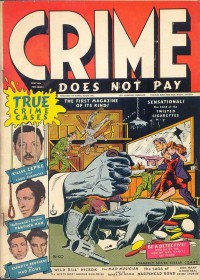True Crime: Insight Into The Human Fascination With The Who-Done-It

Half of Americans say they enjoy true crime — stories portraying real-life instances of murder, kidnapping and other shocking crimes — and 35 percent say they consume true crime content at least once a week. Why are people, especially women, so fascinated with the genre, and how does interest in the who-done-it affect consumers’ thoughts and behaviors

Interest in true crime dates back to ballads about murder in the Middle Ages, broadsheets and pamphlets depicting crimes in the 16th century and interest in the work of investigators in 19th century England. The genre’s modern era was said to have been born in 1965 when the first modern true crime book, In Cold Blood, was published. The ‘nonfiction novel,’ written by American novelist Truman Capote, tells the story of a quadruple murder in Kansas. The book has drawn criticism, and was even banned for a short time, for its gruesome account of the murders. Nonetheless, millions of copies of the novel have been sold.
If anything, interest in true crime has only grown in popularity since, with many high-profile incidents routinely and even repeatedly being covered in books, movies, TV and podcasts. YouGov surveyed 1,000 U.S. citizens 18 and older from August 29 to September 5, 2022, on their consumption of and views toward true crime content. The survey found people view true crime media via a variety of formats. For instance, 52 percent watch TV shows, 39 percent watch films, 23 percent read books, 20 percent watch online videos, 17 percent listen to podcasts and 15 percent view online articles or forums.
Podcasts depicting real-life crime became a phenomenon in 2014 with the launch of Serial, a podcast which in its first season (of three) delved into a 1999 murder of a high school student. Serial reached 5 million iTunes downloads quicker than any previous podcast and has an average of 1.5 million listeners per episode.
A Pew Research Center Study from April 1 to Sept. 30, 2022, indicates true crime is the most common podcast topic, and 24 percent of the 451 top-ranked podcasts in the United States across Apple Podcasts and Spotify are about true crime.
Edison Research compiled a list of the most listened-to podcasts based on audience size in the United States from April 2022 to June 2022. Three true crime podcasts made the top 10: Crime Junkie (second), My Favorite Murder (fifth) and Morbid: A True Crime Podcast (ninth). True crime content is also popular across other mediums, and the limited series DAHMER-Monster: The Jeffrey Dahmer Story, was on the Netflix Global Top 10 list for seven weeks, and has been watched for over a billion hours, making it the third most watched series or movie on Netflix ever.
The YouGov study also looked into which crimes the content covers. Among the participants, 52 percent say murder inspired the content they view, 45 percent say serial-killing, 37 percent say kidnapping and 35 percent say organized crime.
Users who tune in to true crime content are more likely to be female than male; the YouGov survey found 58 percent of women say they enjoy true crime compared to 42 percent of their male counterparts. In “Undisclosed Information – Serial Is My Favorite Murder: Examining Motivations in the True Crime Audience,” researchers Kelli Boling from the University of Nebraska at Lincoln and Kevin Hull at the University of South Carolina explored the primary audience of true crime podcasts. The study found 73 percent of true crime podcast listeners are female. The study also determined that users listen to true crime content primarily to ease boredom or for entertainment or convenience.
“The most popular and commonly accepted explanation for why women love true crime is because they feel, consciously or subconsciously, that they might learn something from it,” journalist Eden Arielle Gordon wrote in “Research Reveals Why Women Love True Crime” for the MagellanTV blog. “This is because women often see themselves (quite literally) in true crime stories.”
Researchers Amanda M. Vicary and R. Chris Fraley from the University of Illinois at Urbana-Champaign assessed the motivations behind consuming true crime content in their paper “Captured by True Crime: Why Are Women Drawn to Tales of Rape, Murder and Serial Killers,” published in Social Psychological and Personality Science. In the study, a group of men and women could choose between two books, one describing how a female victim escaped a crime, and the other in which she did not. The study found women chose the book on a female escaping more often than did men. Women were also more likely to select books with female victims and books detailing a killer’s motives.
While men are more likely to be a victim of a crime, women are more often victims of specific, violent crimes typically featured in true crime content. For instance, 70 percent of victims killed by a partner are women, and of the 1,398 victims of serial killers from 1985 to 2010, 70 percent were women.
Stacy L. Mallicoat, a professor of criminal justice at California State University, Fullerton, provides insight into women’s victimization rates in her book, Women, Gender and Crime. “Women make up a majority of the victims for certain types of crimes, particularly when men are the primary offender,” Mallicoat writes. “These gendered experiences of victimization appear in crimes such as rape, sexual assault, intimate partner abuse and stalking, to name a few.”
Looking beyond gender, psychiatrist Jean Kim notes people may consume true crime content because it reminds people of their luck compared to victims, it helps people feel educated on how to avoid similar situations, it reminds people of their own morality and it makes them feel empathy for the victims.
A Netflix blog post posited several reasons for true crime’s popularity, including curiosity about a killer’s psychology (“Why in the world are people into this stuff? People like to learn about the psychological background of the killer,” the piece quoted Vicary), the ‘rush’ of reading about violence, and the desire to solve the puzzle.

That post also included clinical psychologist Michael Mantell raising the possibility that reading about someone else’s tragedies makes us part of the scene — but at a safe remove: “We watch crime because it allows us to feel compassion, not only for the victims but sometimes for the perpetrator[s] as well. It helps us feel secure.” And yet, true crime stories may be inducing fear in viewers. In the Journal of Communication paper “Television News and the Cultivation of Fear of Crime,” researchers at the University of Pennsylvania surveyed 2,300 residents in Philadelphia to determine the connection between consumption of “violent dramatic programming” — in particular when presented in the local nightly news — and perceptions of crime. The study found people who frequently view crime-related local television programs are more likely to fear crime and overestimate the prevalence of crime.
In the YouGov survey 61 percent of respondents said they believe true crime makes people more empathetic, and 28 percent less empathetic. Twenty percent think it makes people more likely to commit a crime, and 29 percent less likely. Similarly, 62 percent said they think it makes people more vigilant and aware of their safety, while 40 percent think it makes people needlessly scared or paranoid.
In “Association Between Fear of Crime and Mental Health and Physical Functioning,” researchers at the International Institute for Society and Health at the University College London Department of Epidemiology and Public Health found fear of crime is associated with reduced mental health, declines in physical functioning and diminished quality of life. The study also found fear of crime can result in emotional and behavioral changes like avoidance of social activities and outside places, mistrust in others, anxiety, paranoia and more.
Historian Joy Wiltenburg discusses the implications of crime-related fears due to crime consumption in, “In True Crime: The Origins of Modern Sensationalism.” “The fears sparked by perceptions of crime influence decisions about where to live, how to raise children, where to invest social wealth, what punitive government actions to support, how to view groups perceived as likely criminals – a broad range of choices and attitudes that affect the quality of a society and its political life,” she wrote.
Nonetheless, true crime content impacts each consumer differently, and with 64 percent of people describing true crime as exciting and suspenseful, it will likely remain a top-grossing genre, despite the fear it presumably causes.
In “True Crime: The Regular Reinvention of a Genre,” Australian researcher and true crime writer Rachel Frank wrote, “The true crime genre ensures there will always be a market for murder.”



























































































